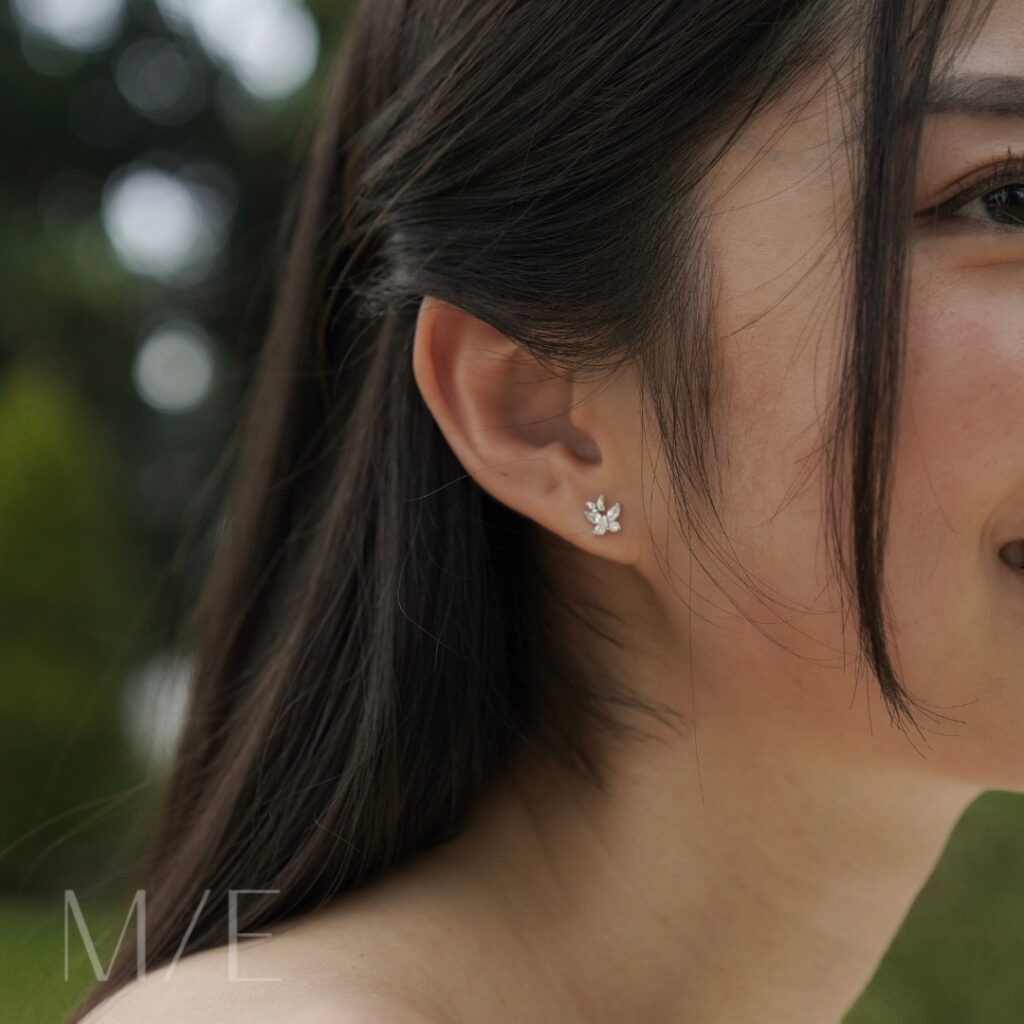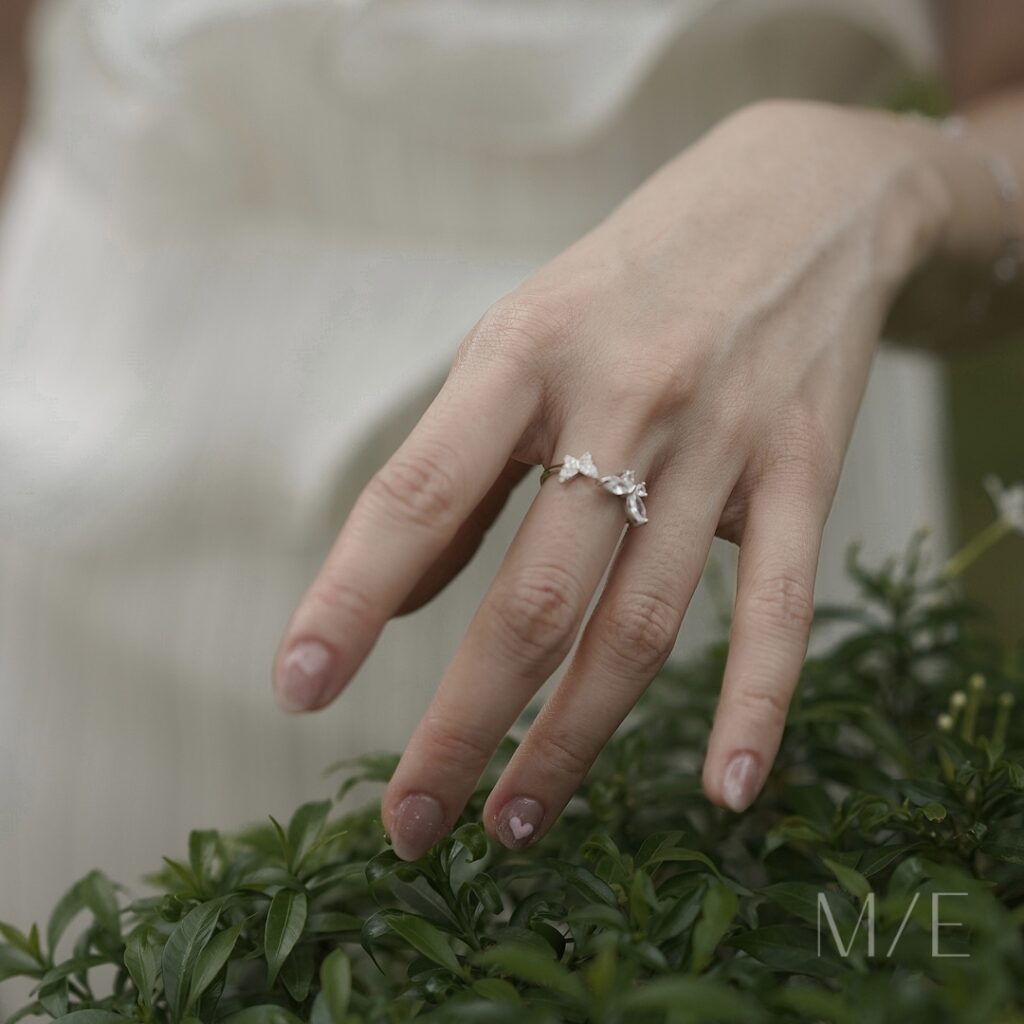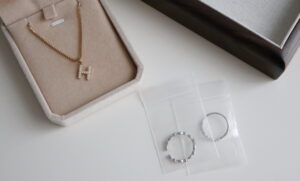
“Consider your jewelry as the last thing you put on in the morning, and the first thing you take off at night.”

JEWELRY MATERIAL AND CARE
Our jewelry is made to be well-loved by you. Your jewelry will last depends on how you take care of them.With proper care, it will continue to shine. And we are here to help ensure your favourite jewelry stays in the best condition, looking as good as new.
- Keep perfume, hair spray, lotions, and other harsh chemicals off from your jewelry.

- When not being worn, store your jewellery in a safe and clean place to prevent damage/oxidation. Ensure those pieces are completely dry before storing. We recommend storing your pieces in a ziplock or a box lined with an anti-tarnish microsuede fabric.

- Remove jewelry when bathing, showering, or swimming in the sea or the swimming pool. Some jewelry are water and sweat resistant, yet to keep them stay in the best condition, keep away from water and excessive sweating.
STERLING SILVER 925
Sterling Silver is made of 92.5% pure silver and 7.5% alloy (usually copper), which is very durable. It is easy to shape and gentle to the skin (hypoallergenic enough). The safest and most effective way to polish sterling silver is to wipe it gently with a soft cloth. Always store sterling silver jewelry in a cool, dry place away from any moisture.
Sterling silver with real silver color can be taken into the shower daily with mild cleanser. If it’s plated with gold/rose gold and contains stones (CZ), you need to take special care and avoid water/sweat to prevent the plating from getting stripped away.
You can wear sterling silver jewelry every day, but avoid exposing it to chemicals unless you are experienced and knowledgeable about its proper care and maintenance.
SILVER 999
Silver 999 jewelry refers to jewelry made from 99.9% pure silver, also known as fine silver. The “999” signifies that the silver content is 99.9% pure, with only 0.1% made up of other trace elements.
Silver 999 is softer and more malleable compared to sterling silver, which is an alloy containing 92.5% silver and 7.5% other metals (usually copper) for added strength. Because of its softness, fine silver is often used for pieces that require less wear and tear, such as earrings and pendants, rather than rings and bracelets which are more prone to scratches and deformation.
Since silver 999 contains 99.9% pure silver and only 0.1% trace elements, it is less likely to cause allergic reactions. This makes it a good choice for people with sensitive skin or metal allergies.
STAINLESS STEEL
Stainless steel is a highly durable metal, allowing it to withstand the wear and tear of everyday activities. It is hypoallergenic and mostly safe for sensitive skin. Gold and rose gold plated stainless steel also has a good durability. The 14/18k plating can last about 1 year (even more) before it starts to wear off. However, this depends a lot on how often the jewelry is being worn or exposed to harsh chemicals. They will however lose their shine over time.
RHODIUM PLATING
Rhodium plating is a process in which a thin layer of rhodium, a rare, precious metal, is applied to the surface of jewelry. Rhodium is a member of the platinum group of metals and is known for its exceptional hardness, bright white color, and resistance to tarnish and corrosion.
Rhodium plating gives jewelry a brilliant, reflective white finish, making it look more lustrous and shiny. This is particularly popular for white gold and silver jewelry, which can benefit from the added brightness.
Over time, the rhodium plating can wear off, especially on pieces that are subject to frequent friction or contact, such as rings. When this happens, the jewelry may need to be re-plated to restore its original appearance.
GOLD PLATING
Gold plating is a process in which a thin layer of gold is applied to the surface of a base metal or alloy. This technique is commonly used in jewelry making to give pieces the appearance of solid gold at a more affordable cost.
Common thicknesses range from 1 to 2.5 microns. Thicker plating lasts longer and is more resistant to wear and tarnish.
However, gold plating is not as durable as solid gold. The gold layer can wear off over time, especially with frequent use or exposure to abrasive materials.
If gold jewelry is your preference, consider gold stainless steel, which has a longer-lasting gold plating compared to silver jewelry.
STAINLESS STEEL VS SILVER JEWELRY
Stainless Steel Jewelry is ideal for those who need durable, low-maintenance, and affordable pieces that can withstand daily wear and tear. It is also a good option for those with metal allergies.
Stainless steel requires minimal maintenance. It does not tarnish or oxidize, making it easy to care for.
Silver Jewelry is perfect for those who appreciate the aesthetic and value of a precious metal, and who don’t mind the extra care needed to maintain its shine and appearance. It is also a better choice for intricate designs and more prestigious pieces.
Silver is a precious metal, and silver jewelry is often seen as more prestigious and valuable compared to stainless steel. It is softer and more malleable, making it easier to create intricate and detailed designs.
Ultimately, the choice between stainless steel and silver jewelry depends on personal preferences, lifestyle, and budget.
The more intentional you are about caring for your jewelry, the longer it will last.
Give some love to your jewelry!
